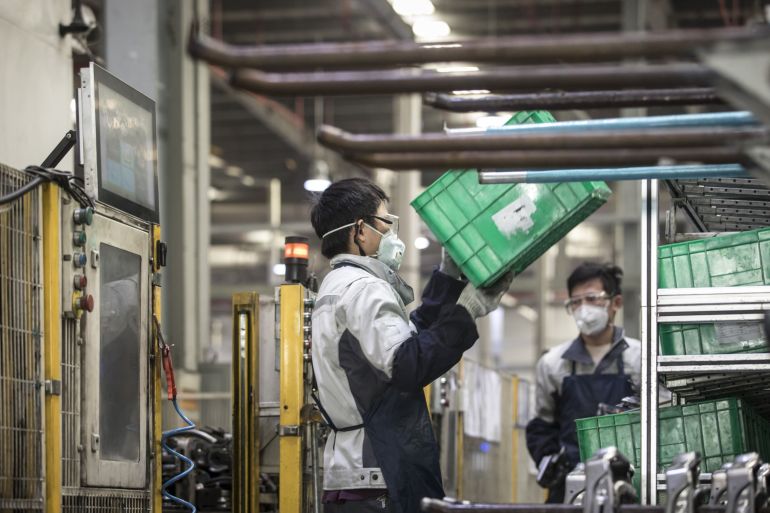China’s factory recovery slows as higher costs hurt businesses
Surprisingly strong exports have helped Chinese manufacturers rebound from COVID-19, but rise in infections clouds future.

China’s factory activity expanded in December as strong export demand fuelled a recovery in the world’s second-largest economy from the year’s coronavirus slump, although higher labour and transport costs slowed the pace of growth.
The official manufacturing Purchasing Manager’s Index (PMI) fell to 51.9 in December from 52.1 in November, data from the National Bureau of Statistics (NBS) showed on Thursday.
Keep reading
list of 4 itemsChina to leapfrog US as world’s biggest economy by 2028: Report
‘Never say never’: How two small Hong Kong firms survived COVID
EU, China sign investment deal 7 years in the making
The index remained above the 50-point mark that separates growth from contraction but was slightly below the 52.0 level predicted in a Reuters’ poll of analysts.
China’s vast industrial sector has staged an impressive recovery from the severe lockdowns in early 2020 to control in the spread of the coronavirus thanks to surprisingly strong exports.
![China official PMI chart [Bloomberg]](/wp-content/uploads/2020/12/366985218-1.jpg?w=770&resize=770%2C433)
The economy is expected to expand about 2 percent for the full year – the weakest pace in more than 30 years but much stronger than other large economies still struggling to contain infections.
However, tougher coronavirus control measures in many of its key trading partners in the West and recent domestic infections could dent industrial demand, weighing on the recovery.
The official PMI, which largely focuses on big and state-owned firms, showed the sub-index for new export orders stood at 51.3 in December, easing from 51.5 a month earlier.
But an index for factory prices rose strongly, reflecting solid overseas demand as well as increased shipping costs, even though some export markets are under lockdown, said Iris Pang, chief economist for Greater China at ING.
Economic indicators ranging from trade to producer prices all suggest a further rebound in the industrial sector.
A sub-index for small business activity stood at 48.8 in December, sharply down from November’s 50.1 and returning to contraction.
Pressure on small firms
Zhao Qinghe, an official at the NBS, said in a statement accompanying the data release that small businesses were pressured by higher labour, raw material and distribution costs.
“Small manufacturers also suffer from the problem of hiring labour as the service sector in China is competing for workers,” said Pang.
A sub-index for employment in the official PMI stood at 49.6 in December, slightly up from November’s 49.5.
China has also seen strong improvement in retail sales driven by firm demand for autos and communication equipment.
In the services sector, activity expanded for the 10th straight month, albeit at a somewhat slower clip. An indicator for construction activity rose at a faster pace.
Ahead of China’s peak travel season, the capital Beijing imposed lockdowns on some COVID-infected areas, the first since the last coronavirus outbreak in the months of June and July.